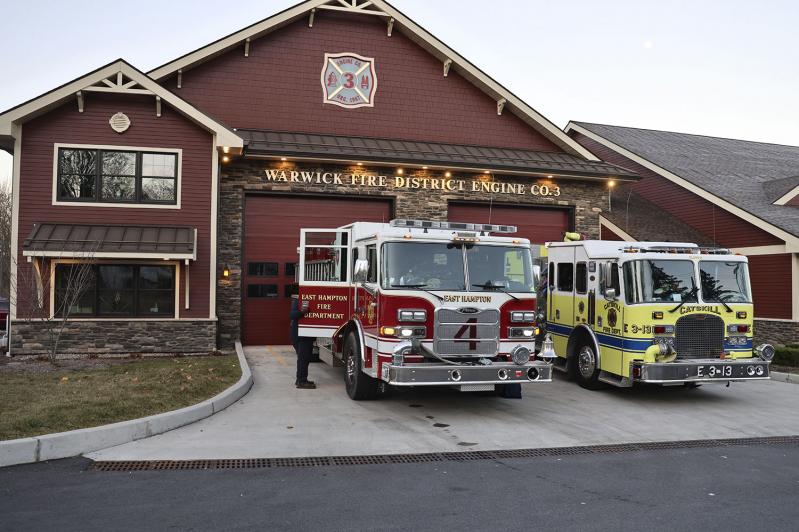East Hampton and Amagansett firefighters volunteered to head north last week to help fight a 5,000-acre wildfire in Orange County, N.Y., not once but twice, battling unfamiliar terrain to do so.
“There’s 109 fire departments in Suffolk County that were all given this same letter Saturday night [Nov. 9] at around six o’clock,” said Gerry Turza, an ex-chief of the East Hampton department. “Ten of us responded out of 109, and we’re going up for our second wave.”
The crew left for Orange County at around 1:30 a.m. on Nov. 11, rendezvousing with the other departments at Dix Hills. The convoy headed north at 3:45 a.m., and arrived at 5:45 a.m. After an 8 a.m. briefing, the volunteers were on site around 9. The work didn’t end until 6 p.m., and the fire crews didn’t get back to the East End until around 10 p.m. Then, on Saturday, the departments returned north.
“You never know what you’re going to do,” Mr. Turza said on Friday. “They called for us because they needed help. We went up and we were given a job, and we did the job.”
In the end, the day lasted some 24 hours, Mr. Turza said, and in those situations, the firefighters are expected to be active for 12 hours at any given time.
“They fight fires completely differently than we do when we have a brush fire, so it was different,” Chris Beckert, chief of the Amagansett department, said of the first trip. “Learned a lot, good working with the other departments.”
Mr. Turza, a 33-year veteran of the East Hampton department, also spoke about the different techniques.
“It was a completely different type of operating environment for us,” he said. “Long Island is flat. Up there, we were in mountainous terrain.”
In Orange County, fighting wildfires is done on foot, he said, which makes it difficult to get close with water. Instead, the firefighters establish burn lines, which help starve the fire of fuel before it encroaches on roads or houses.
“This was something different,” Mr. Turza said. “We weren’t getting to the fire. This was all extremely rough, rugged terrain.” To help starve the fire, other departments were doing landscaping work, such as clearing brush, moving trees, and making footpaths.
Both East Hampton and the East Marion Fire Department took a tanker truck north, so they worked together to establish a water supply for replenishment. From the Amagansett department’s perspective, Chief Beckert described working with the other crews — Orient, Dix Hills, Huntington, Southampton, etc. — as a “good experience.”
In the past, Chief Beckert had cooperated on fires with the Southampton Fire Department, but in general “all of the departments work really well together. We were all there to work, and they gave us work.” Amagansett took six firefighters to Orange County, while East Hampton took four.
“The first half of the day we were basically monitoring a fire line, looking for spot fires, and then we moved to another area to help out a local department with spot fires around a local neighborhood that was unprotected,” Chief Beckert said.
The East Hampton Fire Department had a similar main assignment. The department was “fortunate” to be “constantly working,” as many other departments weren’t as active.
“The main assignment was to patrol and contain any fire that came across the fire line,” Mr. Turza said. There was a road that traversed several neighborhoods and served as the only way in and out for residents. On one side of the road, the Department of Environmental Conversation had established a burn line, and the local firefighters oversaw extinguishing the hotspots that flared up along that line.
From the air, Black Hawk helicopters from the National Guard were dropping water buckets nearby. On the New York side of the fire, Mr. Turza said, airships dropped 120 buckets of water.
The elements presented another concern for the local firefighters; a recent lack of rainfall, low humidity, and 35-mile-per-hour wind gusts compounded to create unfavorable conditions for putting out the fire.
“It was kind of interesting,” Mr. Turza said. “We’ve done these kinds of things before on a different scale here in Suffolk County, but this was a little different, just given the terrain and the fact that instinctively what we want to do is we want to go, and we want to take the fire head-on.”
Orange County was the farthest Chief Beckert or Mr. Turza had traveled to fight a fire, though he said that local departments had traveled to Buffalo to help with emergency relief during a blizzard in the 1970s.
“These are regular-people homes,” Mr. Turza said. “These are not gigantic castles and mansions or things like that with sprawling acreage. These are normal, everyday people’s homes. You’re looking across the street and there’s smoke and flames directly on the other side of the street. We were up there, and we were doing our thing to make sure those folks felt safe, felt secure.”
Orange County residents were grateful, Chief Beckert said. They gathered around, “giving us food, thanking us — they appreciate it up there.”
“At least for the time we were up there, we were able to provide the residents there with a little sense of relief,” Mr. Turza continued. “Everyone is extremely, extremely happy and appreciative of our efforts up there: residents coming by thanking us, school buses pulling over and the kids waving out the window at us — things like that — people on the way up beeping their horns in support.”



